Dates 1 Jul 1946 – 22 Jul 1958 | ||
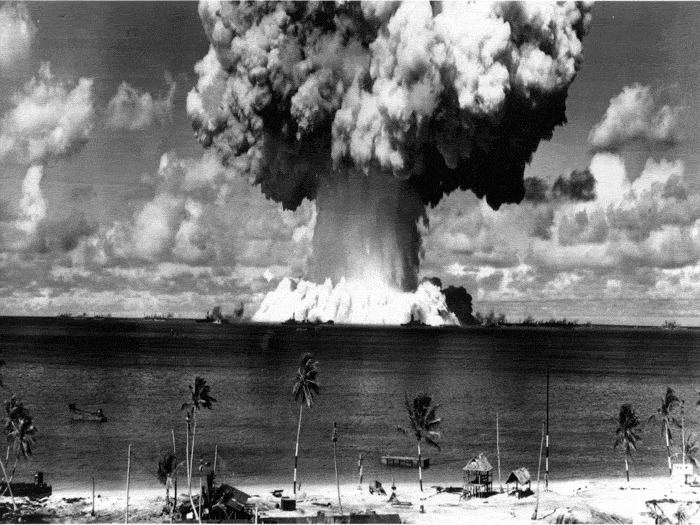 | ||
Location | ||
The nuclear testing at Bikini Atoll program was a series of 23 nuclear devices detonated by the United States between 1946 and 1958 at seven test sites on the reef itself, on the sea, in the air and underwater. The test weapons produced a combined fission yield of 42.2 Mt of explosive power.
Contents
- Residents relocated
- Military services
- Ship graveyard
- Operation Crossroads
- Castle Bravo test
- Castle Bravo contamination
- Local populations affected
- Japanese fishermen contaminated
- Later tests
- Shipwrecks
- Nuclear test detonations at Bikini Atoll
- Strategic Trust Territory
- Return to Bikini Island
- Second evacuation
- Compensation and reparations
- In popular culture
- References
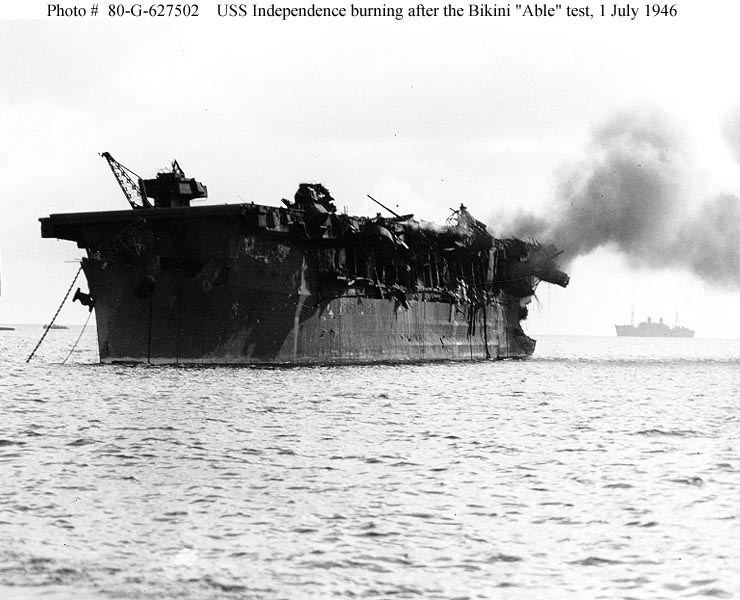
The United States was engaged in a Cold War Nuclear arms race with the Soviet Union to build bigger and better bombs from 1946 until 1992. The first series of tests over Bikini Atoll in July 1946 was code named Operation Crossroads. The first test was dropped from an aircraft and detonated 520 feet (158 m) above the target fleet. The second, Baker, was suspending under a barge. It produced a large Wilson cloud and contaminated all of target ships. Chemist Glenn T. Seaborg, the longest-serving chairman of the Atomic Energy Commission, called the second test "the world's first nuclear disaster."
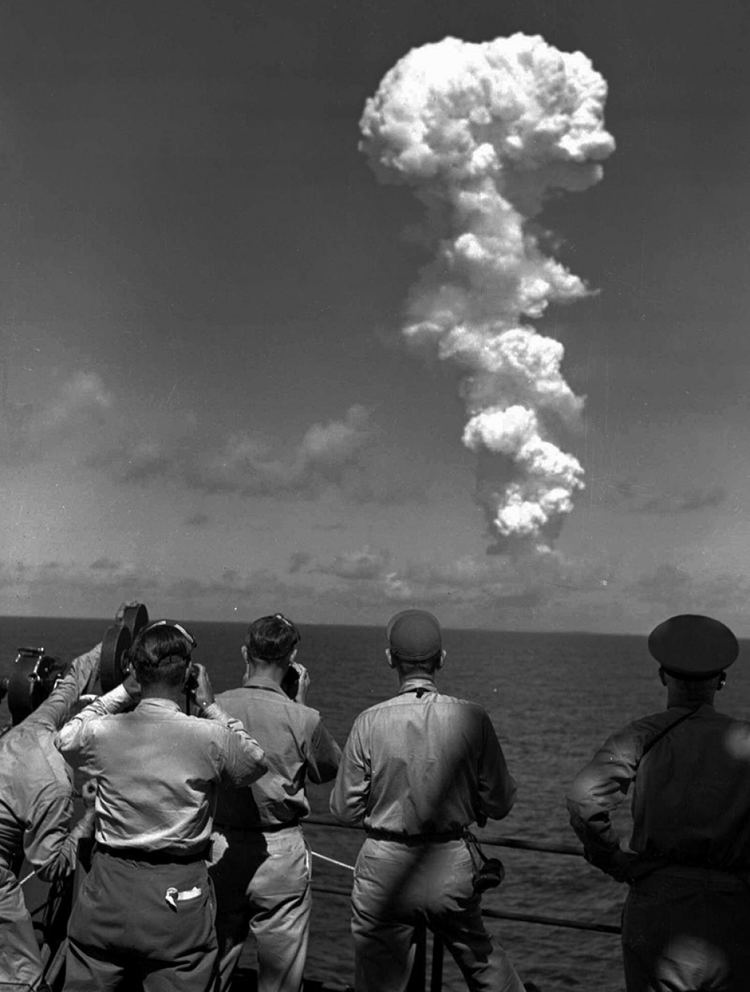
The second series of tests in 1954 was codenamed Operation Castle. The first detonation, Castle Bravo, was a new design utilizing a dry fuel thermonuclear hydrogen bomb. It was detonated at dawn on March 1, 1954. Scientists miscalculated and the 15 megaton nuclear explosion far exceeded the expected yield of 4 to 8 megatons (6Mt predicted), and was about 1,000 times more powerful than each of the atomic bombs dropped on Hiroshima and Nagasaki during World War II. The scientists and military authorities were shocked by the size of the explosion and many of the instruments they had put in place to evaluate the effectiveness of the device were destroyed.
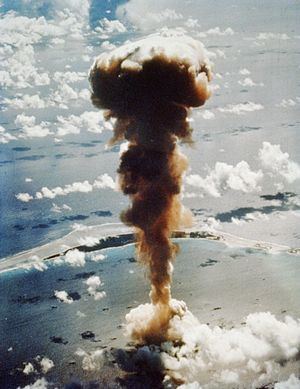
The military authorities and scientists had promised the Bikini Atoll's native residents that they would be able to return home after the nuclear tests. A majority of the island's family heads agreed to leave the island, and most of the residents were moved to the Rongerik Atoll and later to Kili Island. Both locations proved unsuitable to sustaining life, resulting in starvation and requiring the residents to receive ongoing aid.
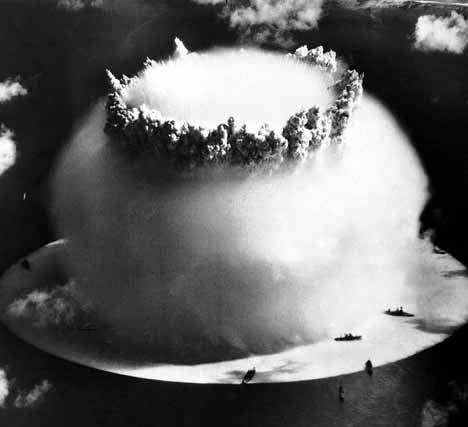
Despite the promises made by authorities, this and further nuclear tests (Redwing in 1956 and Hardtack in 1958) rendered Bikini unfit for habitation, contaminating the soil and water, making subsistence farming and fishing too dangerous. The United States later paid the islanders and their descendants $2 billion in compensation for damage caused by the nuclear testing program and their displacement from their home island. As of 2014, it may be technically possible for the former residents and their descendents to live on the atoll's islands, but virtually none of those alive today have ever lived on the atoll and very few want to move there. In 2016 an article in Science News reported that the radiation levels remained higher than the recommended safe levels for habitation.
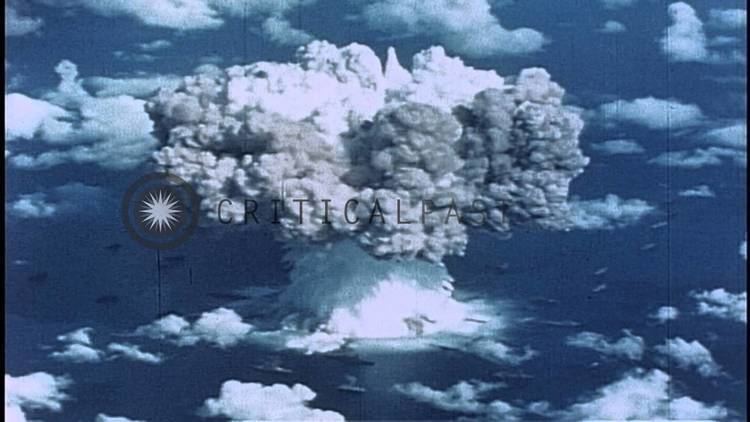
Residents relocated
In February 1946, the United States government asked the 167 Micronesian inhabitants of the atoll to voluntarily and temporarily relocate so the United States government could begin testing atomic bombs for "the good of mankind and to end all world wars." Nine of the eleven family heads, or alaps, chose Rongerik as their new home. United States Navy Seabees helped them to disassemble their church and community house and prepare to relocate them to their new home. On March 7, 1946, the residents gathered their personal belongings and saved building supplies. They were transported 125 miles (201 km) eastward on U.S. Navy landing craft 1108 and LST 861 to the uninhabited Rongerik Atoll, which was one-sixth the size of Bikini Atoll. No one lived on Rongerik because it had an inadequate water and food supply and due to deep-rooted traditional beliefs that the island was haunted by the Demon Girls of Ujae. The Navy left them with a few weeks of food and water which soon proved to be inadequate.
Military services
To conduct the tests, the United States assembled a support fleet of more than 242 ships that provided quarters, experimental stations, and workshops for more than 42,000 personnel. The islands were primarily used as recreation and instrumentation sites. To support the nuclear bomb testing program, Seabees built bunkers, floating dry docks, 75 feet (23 m) steel towers for cameras and recording instruments, and other facilities on the island to support the servicemen. These included the "Up and Atom Officer's Club" and the "Cross Spikes Club", a bar and hangout created by servicemen on Bikini Island between June and September 1946 during the preparation for Operation Crossroads. The "club" was little more than a small open-air building that served alcohol to servicemen and provided outdoor entertainment, including a ping pong table. The "Cross Spikes Club" was the only entertainment the enlisted servicemen had access to during their June to September stay at Bikini.
Ship graveyard
The Bikini Atoll lagoon was designated a ship graveyard by the United States Navy. The United States brought in 95 ships including carriers, battleships, cruisers, destroyers, submarines, attack transports, landing ships, and auxiliary vessels from across the world to test the durability of ships to withstand a nuclear impact. These included the USS Pennsylvania (BB-38), USS New York (BB-34), USS Arkansas (BB-33), USS Nevada (BB-36), USS Saratoga (CV-3), USS Independence (CVL-22), and Admiral Yamamoto's 738 feet (225 m) former flagship, the Japanese battleship Nagato. Aircraft were positioned on the USS Saratoga (CV-3), their wings loaded with ordnance. Military equipment including tanks and other armor was positioned on some of the ships to see how well they survived the nuclear blast. Amphibious craft were berthed on Bikini Island for similar purposes. Live animals including goats were positioned on the ships and shore to test for the impact on living creatures.
The Navy positioned the ships in the lagoon to help assess the damage to vessels, equipment, and material from a nuclear explosion. The task force placed tanks, bulldozers, and other military machinery on the island, along with 150 airplanes on the island's airstrip, to test the effect of a nuclear weapon. The proxy fleet if active would have comprised the sixth largest naval fleet in the world. All carried varying amounts of fuel and some carried live ordnance.
Operation Crossroads
Crossroads consisted of two detonations, each with a yield of 23 kilotons of TNT (96 terajoules). Able was detonated over Bikini on July 1, 1946 and exploded at an altitude of 520 feet (160 m) but was dropped by aircraft about 1,500 to 2,000 feet (460 to 610 m) off target. It sank only five of the ships in the lagoon. The second, Baker, was detonated underwater at a depth of 90 feet (27 m) on July 25, sinking eight ships. The second, underwater blast created a large condensation cloud and contaminated the ships with more radioactive water than was expected. Many of the surviving ships were too contaminated to be used again for testing and were sunk. The air-borne nuclear detonation raised the surface seawater temperature by 55,000 °C (99,000 °F), created blast waves with speeds of up to 8 metres per second (26 ft/s), and shock and surface waves up to 30 metres (98 ft) high. Blast columns reached the floor of the lagoon which is approximately 70 metres (230 ft) deep. The Bikini Island King visited Bikini Atoll in July after the second atomic bomb test code-named Baker and found it apparently in good condition.
A third burst, Charlie, planned for 1947, was canceled primarily because of the United States Navy's inability to decontaminate the target ships after the Baker test. Charlie was rescheduled as Operation Wigwam, a deep water shot conducted in 1955 off the California coast.
Castle Bravo test
The United States was in a Cold War Nuclear arms race with the Soviet Union to build bigger and better bombs. The next series of tests over Bikini Atoll was code named Operation Castle. The first test of that series was Castle Bravo, a new design utilizing a dry fuel thermonuclear hydrogen bomb. It was detonated at dawn on March 1, 1954.
The 15 megaton nuclear explosion far exceeded the expected yield of 4 to 8 megatons (6Mt predicted), and was about 1,000 times more powerful than each of the atomic bombs dropped on Hiroshima and Nagasaki during World War II. The nuclear weapon was the most powerful device ever detonated by the United States (and just under one-third the energy of the Tsar Bomba, the largest ever tested). The scientists and military authorities were shocked by the size of the explosion and many of the instruments they had put in place to evaluate the effectiveness of the device were destroyed.
Castle Bravo contamination
The unexpectedly large yield, combined with other factors, led to the most significant accidental radiological contamination caused by the United States. A few minutes after the detonation, blast debris began to fall on Eneu/Enyu Island on Bikini Atoll where the U.S crew that triggered the device were located. When their geiger counters detected the unexpected fallout, they were forced to shelter in place indoors for a number of hours before it was safe enough for an airlift rescue operation to be carried out.
After impacting Eneu, the fallout continued to spread across the inhabited islands of the Rongelap, Rongerik, and Utrik Atolls. The inhabitants of Rongelap and Rongerik Atolls were evacuated by US servicemen two days after the detonation, but the residents of the more distant Utrik Atoll weren't evacuated for three days. Many of the inhabitants soon began to show symptoms of acute radiation syndrome. They returned to the islands three years later but were forced to relocate again when their islands were found to be unsafe.
The fallout gradually dispersed around the globe, depositing traces of radioactive material in Australia, India and Japan, and parts of the United States and Europe. Though organized as a secret test, Castle Bravo quickly became an international incident, prompting calls for a ban on the atmospheric testing of thermonuclear devices.
Local populations affected
The Rongelap Atoll was coated with up to 2 centimetres (0.79 in) of snow-like irradiated calcium debris and ash over the entire island. Virtually all the inhabitants experienced severe radiation sickness, including itchiness, sore skin, vomiting, diarrhea, and fatigue. Their symptoms also included burning eyes and swelling of the neck, arms, and legs. The inhabitants were forced to abandon the islands, leaving all their belongings, three days after the test. They were relocated to Kwajalein for medical treatment.
Six days after the Castle Bravo test, the U.S government set up a secret project to study the medical effects of the weapon on the residents of the Marshall Islands.
The United States was subsequently accused of using the inhabitants as medical research subjects, without obtaining their consent, to study the effects of nuclear exposure. Until that time, the United States Atomic Energy Commission had given little thought to the potential impact of widespread fallout contamination and health and ecological impacts beyond the formally designated boundary of the test site.
Japanese fishermen contaminated
Ninety minutes after the detonation, 23 crew members of the Japanese fishing boat the Daigo Fukuryū Maru ("Lucky Dragon No. 5") also were contaminated by the snow-like irradiated debris and ash. They had no idea what the explosion they'd seen meant nor any inkling of the nature of the deadly debris that rained down on them like snow. But they all soon became ill with the effects of acute radiation poisoning. One fisherman died almost a half year later while under doctor supervision in late September, with his cause of death regarded to have been due to underlying liver cirrhosis compounded by an infection. The majority of medical experts believe that the crew members were infected with hepatitis C through blood transfusions during part of their Acute radiation syndrome treatment.
Edward Teller, one of the driving minds behind the development of the hydrogen bomb, and architect of the Marshall Island tests, upon learning of the death of the fisherman through the mass media which painted his death as a anti-nuclear casus belli, commented, “It’s unreasonable to make such a big deal over the death of a fisherman.”
Later tests
The seventeen-shot Redwing series followed—eleven tests at Enewetak Atoll and six at Bikini. The island residents who had been promised they would be able to return home to Bikini was thwarted indefinitely by the U.S. decision to resume nuclear testing at Bikini in 1954. During 1954, 1956, and 1958, twenty-one more nuclear bombs were detonated at Bikini, yielding a total of 75 megatons of TNT (310 PJ), equivalent to more than three thousand Baker bombs. Only one was an air burst, the 3.8 megaton Redwing Cherokee test. Air bursts distribute fallout in a large area, but surface bursts produce intense local fallout. These tests were followed by the 33-shot Hardtack tests which began in late April 1958. The last of ten tests were detonated on Bikini Atoll on 22 July 1958.
Shipwrecks
Shipwrecks in the lagoon include:
Nuclear test detonations at Bikini Atoll
The following above-ground nuclear device tests were conducted on or near Bikini Atoll from 1946 to 1958, comprising 15.1% of total test yield worldwide.
Strategic Trust Territory
In 1947, the United States convinced the United Nations to designate the islands of Micronesia a United Nations Strategic Trust Territory. This was the only trust ever granted by the U.N. The United States Navy controlled the Trust from a headquarters in Guam until 1951, when the United States Department of the Interior took over control, administering the territory from a base in Saipan. The directive to which the United States agreed stipulated that it would "promote the economic advancement and self-sufficiency of the inhabitants, and to this end shall... protect the inhabitants against the loss of their lands and resources..."
Despite the promise to "protect the inhabitants," from July 1946 through July 1947 the residents of Bikini Atoll were left alone on Rongerik Atoll. In January 1948, Dr. Leonard Mason, an anthropologist from the University of Hawaii, visited the temporary home of the relocated islanders on Rongerik Atoll and was horrified when he found the people were starving. A team of U.S. investigators concluded in late 1947 that the islanders must be moved immediately. Press from around the world harshly criticized the U.S. Navy for ignoring the people. Harold Ickes, a syndicated columnist, wrote "The natives are actually and literally starving to death."
The Navy then selected Ujelang Atoll for their temporary home and some young men from the Bikini Atoll population went ahead to begin constructing living accommodations. But U.S. Trust Authorities changed their mind. They decided to use Enewetak Atoll as a second nuclear weapons test site and relocated that atoll's residents to Ujelang Atoll instead and to the homes built for the Bikini Islanders.
In March 1948, 184 malnourished Bikini islanders were temporarily relocated again to Kwajalein Atoll. In June 1948 the Bikini residents chose Kili Island as a long-term home. The small, 200 acres (81 ha) (.036 square miles (0.093 km2)) island, one of the smallest islands in the Marshall Island chain, was uninhabited and wasn't ruled by a paramount iroij, or king. In November 1948, the residents, now totaling 184 individuals, moved there. Living on Kili Island effectively destroyed their culture that had been based on fishing and island-hopping canoe voyages to various islets around the Bikini Atoll. Kili does not provide enough food for the transplanted residents.
Return to Bikini Island
In June 1968, based on scientific advice that the radiation levels were sufficiently reduced, President Lyndon B. Johnson promised the 540 Bikini Atoll families living on Kili and other islands that they would be able to return to their home. But the Atomic Energy Commission learned that the coconut crabs, an essential food source, retained high levels of radioactivity and could not be eaten. The Bikini Council voted to delay a return the island as a result.
In 1987, a few Bikini elders returned to the island to reestablish old property lines. Construction crews began building a hotel on Bikini, and installed generators, desalinators, and power lines. A packed coral and sand runway still exists on Enyu Island. Three extended families, eventually totaling about 100 people, moved back to their home island in 1972 despite the risk. But 10 years later a team of French scientists found some wells were too radioactive for use and determined that the pandanus and breadfruit were also dangerous for human consumption. Women were experiencing miscarriages, stillbirths, and genetic abnormalities in their children. The U.S.-administered Strategic Trust Territory decided that the islanders had to be evacuated from the atoll a second time.
Second evacuation
Following their evacuation from the island, an 11-year-old boy, born on Bikini in 1971, died from cancer that was linked to radiation exposure he received while living on Bikini. The records obtained by the Marshallese Nuclear Claims Tribunal later revealed that Dr. Robert Conard, head of Brookhaven National Laboratory's medical team in the Marshall Islands, understated the risk of returning to the atoll. Dr. Konrad Kotrady was contracted by Brookhaven National Laboratory (BNL) to treat the Marshall Island residents. In 1977, he wrote a 14-page report to BNL that raised serious questions about the residents' return to Bikini and questioned the accuracy of Brookhaven's prior work on the islands. After they were promised their home was safe, and then being removed after this was found to be wrong, the Bikini Atoll islanders grew to distrust the official reports of the U.S. scientists.
The special International Atomic Energy Agency (IAEA) Bikini Advisory Group determined in 1997 that "It is safe to walk on all of the islands ... although the residual radioactivity on islands in Bikini Atoll is still higher than on other atolls in the Marshall Islands, it is not hazardous to health at the levels measured ... The main radiation risk would be from the food: eating locally grown produce, such as fruit, could add significant radioactivity to the body...Eating coconuts or breadfruit from Bikini Island occasionally would be no cause for concern. Eating many over a long period of time without having taken remedial measures, however, might result in radiation doses higher than internationally agreed safety levels." IAEA estimated that living in the atoll and consuming local food would result in an effective dose of about 15 mSv/year.
After the aborted resettlement in 1978, the leaders of the Bikini community have insisted since the early 1980s that the top 15 inches (38 cm) of soil be excavated from the entire island. Scientists reply that while removing the soil would rid the island of cesium-137, it would also severely damage the environment, turning the atoll into a virtual wasteland of windswept sand. The Bikini Council has repeatedly contended that removing the topsoil is the only way to guarantee future generations safe living conditions.
In 1997, researchers found that the dose received from background radiation on the island was between 2.4 mSv/year—the same as natural background radiation—and 4.5 mSv/year, assuming that residents consumed a diet of imported foods. Because the local food supply is still irradiated, the group did not recommend resettling the island. A 1998 International Atomic Energy Agency report found that Bikini is still not safe for habitation because of dangerous levels of radiation.
A 2002 survey found that the coral inside the Bravo Crater has partially recovered. Zoe Richards of the ARC Centre of Excellence for Coral Reef Studies and James Cook University observed matrices of branching Porites coral up to 8 meters high.
Compensation and reparations
In 1975 the islanders, who had returned to Bikini Atoll and later learned that it wasn't safe, sued the United States for the first time. They demanded a radiological study of the northern islands. In 1975, the United States set up The Hawaiian Trust Fund for the People of Bikini, totaling $3 million. When the islanders were removed from the island in 1978, the U.S. added $3 million to the fund. The U.S. created a second trust fund, The Resettlement Trust Fund for the People of Bikini, containing $20 million in 1982. The U.S. added another $90 million to that fund to pay to clean up, reconstruct homes and facilities, and resettle the islanders on Bikini and Eneu islands.
In 1983, the U.S. and the Marshall islanders signed the Compact of Free Association, which gave the Marshall Islands independence. The Compact became effective in 1986 and was subsequently modified by the Amended Compact that became effective in 2004. It also established the Nuclear Claims Tribunal, which was given the task of adjudicating compensation for victims and families affected by the nuclear testing program. Section 177 of the compact provided for reparations to the Bikini islanders and other northern atolls for damages. It included $75 million to be paid over 15 years. On March 5, 2001, the Nuclear Claims Tribunal ruled against the United States for damages done to the islands and its people.
The payments began in 1987 with $2.4 million paid annually to entire Bikini population, while the remaining $2.6 million is paid into The Bikini Claims Trust Fund. This trust is intended to exist in perpetuity and to provide the islanders a 5% payment from the trust annually.
The United States provided $150 million in compensation for damage caused by the nuclear testing program and their displacement from their home island.
By 2001, of the original 167 residents who were relocated, 70 were still alive, and the entire population has grown to 2800. Most of the islanders and their descendents live on Kili, in Majuro, or in the United States. The opportunity for some Bikini islanders to potentially relocate back to their home island creates a dilemma. Only a few living islanders were born there. Most of the younger generation have never lived there or even visited and do not have a desire to return. Unemployment in the Marshall Islands was as of 2013 at about 40 percent. The population is growing at a four percent growth rate, so increasing numbers are taking advantage of terms in the Marshall Islands’ Compact of Free Association that allow them to obtain jobs in the United States.
